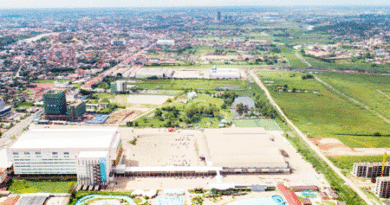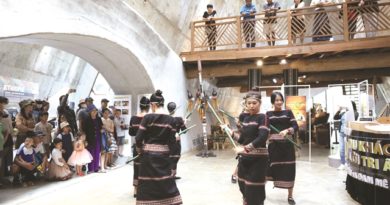JLL Philippines Director of Commercial Leasing, Antonio Sabarre, JLL Philippines National Director and Head of Capital Markets, Ryan Isip, JLL Regional Director and Head of Commercial Leasing, Lizanne Tan, JLL Philippines Country Head, Christophe Vicic, JLL Philippines Head of Research and Consultancy, Janlo De Los Reyes / posted January 14, 2019 at 05:02 pm
.
The Philippine real estate industry is forecast to maintain its growth and remain resilient in 2019. This is based on research and data gathered by industry leader JLL which reported an upward trend in the office, residential, retail, and hospitality sectors of the Philippine property market in 2018.
.
In 2018, an estimated 1 million square meters of office space was added to the current stock – whereby 72% of the 9.1 million existing office space has been leased out. Average vacancy of existing office space remained manageable at 7%. Identified as leading space occupiers as of the 4Q 2018 are Business Process Outsourcing (BPO), Online Gaming and Flexible Workspace providers.Office rents, meanwhile, maintained its growth backed by solid demand- despite construction delays and headwinds brought forth by interest hikes, delayed Philippine Economic Zone Authority (PEZA) accreditations on buildings and apprehensions on the Tax Reform for Acceleration and Inclusion (TRAIN) 2 law.
.
Capital values also gained steadily due to the sound business environment which continued to buoy investors’ interest.JLL Philippines Director of Commercial Leasing, Antonio Sabarre, JLL Philippines National Director and Head of Capital Markets, Ryan Isip, JLL Regional Director and Head of Commercial Leasing, Lizanne Tan, JLL Philippines Country Head, Christophe Vicic, JLL Philippines Head of Research & Consultancy, Janlo De Los Reyes Residential condominium supply grew in 2018 with approximately 35,000 units added to the total existing stock. Overall, total cumulative stock last year reached 338,000 units with majority of the stock located in Quezon City followed by Makati City and Taguig City.Strong demand was observed for newly completed residential units and pipeline of projects from the upper-mid to luxury segments in Makati and Bonifacio Global City (BGC).
.
.
The leasing market in Makati Central Business District (CBD) and BGC was mainly driven by the influx of expatriate employees from BPO and online gaming firms while the sales market was fueled by the demand from local and foreign high net worth individuals.In terms of rents, Bay Area, which covers Pasay and Paranaque City, exhibited strong rental growth owing to the housing requirements of China-based online gaming firms. Meanwhile, Makati City and Taguig City continued to command the highest rates at Php1,800 and Php1,900 per square meter per month, respectively, due to the stable leasing and sale demand for residential units in the business hubs of Makati CBD and BGC.Bangko Sentral ng Pilipinas’ latest residential real estate price in the third quarter of 2018 showed an increase in residential condominium prices in Metro Manila, up 6.4% year-on-year, suggesting stable demand.An estimate of 348,900 sqm of retail space was completed in 2018 with total existing stock reaching 6.5 million square meters. Average vacancy rates of retail shopping centers remained low at 3.7% in the 4Q 2018, backed by healthy demand for retail spaces by foreign and local retailers. The fashion segment led the expansion activity among foreign brands while the F&B sector drove retail activity of local brands.
.
This sustained entry and expansion of brands drove positive rental growth of the retail sector.Additional stock completed in 2018 added around 3,000 rooms, with majority of the new supply found in the Bay Area due to the uptick in real estate investments in this area. International brands such as the Grand Hyatt by the Hyatt Corporation, Citadines Bay City Manila by the Ascott Limited, and Hilton Manila City by the Hilton Worldwide were some of the new developments that completed last year.The tourism sector maintained its positive trajectory. Despite the closure of Boracay for its rehabilitation, cumulative foreign tourist arrivals from January to October 2018 posted a growth of 7.4% year-on-year.With the existence of the Philippines’ Bay City, which is envisioned to be the Las Vegas of the Philippines, Paranaque City had the highest maximum room rate per night at Php18,800 per room per night due to the presence of hotel-casino brands.
.
Forecasts on the office sector remain positive for 2019. On the supply side, a large volume of office space is anticipated to be added this year while on the demand side, office occupancy from BPO, online gaming, and flexible workspace firms show optimistic outlook with pre-commitments on office buildings in the pipeline. Rents are foreseen to have an upward trajectory due to healthy leasing demand and continued investor interest will prop up capital values of office developments.
The residential sector is predicted to thrive in 2019 due to the strong demand for upper-mid to luxury segments with developments’ pre-sold units ranging from 80% to 100%. The residential leasing market in Makati and BGC is also expected to benefit from the spillover effect of healthy demand for office spaces from BPO and online gaming firms.The sound macroeconomic environment of the Philippines is likely to support the retail market in 2019, with retailers taking advantage of the rising disposable income of Filipinos. The relaxation of the Trade Liberalization Act of the Philippines may increase foreign investments coming to the Philippines because of the lower paid-up capital requirement. The government’s discussions on the actualization of the Real Estate Investment Trust (REIT) law may also encourage more investment in the retail market.The hospitality sector will sustain its robust performance in 2019. Foreign hotel operators are likely to enter the Philippine market and form partnerships with local developers. The government’s continuing support of the tourism industry evidenced by its infrastructure push to improve the accessibility of tourist destinations is forecast to have a positive effect on tourism in 2019 thereby enabling growth in the hospitality sector.2019 will be a year that further showcases the emergence of new trends and opportunities in the Philippine real estate industry. The cultural shift led by the millennial generation to a community- based lifestyle will drive the popularity of co-working and co-living in the Philippines. The increasing demand for co-working spaces will encourage more foreign flexible space operators to increase their presence in 2019.Flexible space operators like WeWork and IWG have extended their footprint in the country and are expected to expand in 2019. More local providers of co-working and co-living spaces are also expected to emerge, typically operating in fringe areas. The lower capital costs these types of assets require will spark investor interest.Logistics is another asset type that is expected to thrive in 2019. The emergence of e-commerce firms will support the logistics sector as shipment and transportation of merchandise will be needed.
.
.
Lazada and Zalora, for example, have greatly expanded their operations in the Philippines that will benefit the logistics sector.Foreign and local government policies will, undoubtedly, affect the real estate industry in 2019. The US-China trade war, for example, has created a huge opportunity for the Philippine property market as China is looking at spaces/lands in other countries because of tariffs imposed by the US. The Build, Build, Build (BBB) policy of the Philippine government has spurred investment activity in areas such as Clark City and the province of Pampanga where the BBB projects like the expansion of Clark International Airport, The Subic Cargo Railway, etc. are in the pipeline. The government’s infrastructure push also creates a spillover effect to surrounding provinces. The TRAIN 2 (Trabaho) and the REIT law, once implemented, will affect the property industry in 2019 as well.JLL says the outlook for the Philippine real estate industry in 2019 remains positive. The demand for real estate space by the BPO sector as well as increasing demand from emerging real estate stakeholders like technology companies and flexible space operators will continue to make significant inroads into the Philippines’ property market in 2019. This expected growth and expansion of the industry in 2019 will hopefully encourage investments in the next wave cities of Davao, Cebu, Clark, Cagayan de Oro, Iloilo, and Bacolod. As such, 2019 is anticipated to be another solid year for the Philippine real estate industry. Barring any hitches from the upcoming 2019 elections, apprehensions over the implications of TRAIN 2, and the delay in PEZA accreditations on buildings, the year 2020 already looks just as promising.
.
.
 All photographs, news, editorials, opinions, information, data, others have been taken from the Internet ..aseanews.net | [email protected] | For comments, Email to : Rovich Land– Contributor
All photographs, news, editorials, opinions, information, data, others have been taken from the Internet ..aseanews.net | [email protected] | For comments, Email to : Rovich Land– Contributor


 All photographs, news, editorials, opinions, information, data, others have been taken from the Internet ..aseanews.net |
All photographs, news, editorials, opinions, information, data, others have been taken from the Internet ..aseanews.net | 






